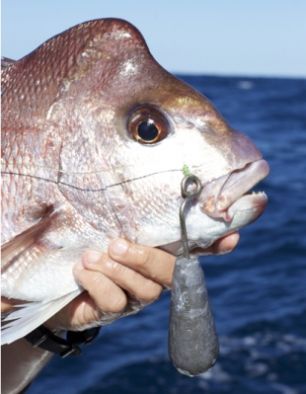Barotrauma and Release Weights
 Many popular recreational fish species, such as Mulloway, Pearl Perch and Snapper, are often caught from water deeper than 10 metres. Fish hooked at such depths can display a range of injuries due to changes in water pressure as they are brought to the surface. These injuries are known as barotrauma and can affect the survival of released fish.
Many popular recreational fish species, such as Mulloway, Pearl Perch and Snapper, are often caught from water deeper than 10 metres. Fish hooked at such depths can display a range of injuries due to changes in water pressure as they are brought to the surface. These injuries are known as barotrauma and can affect the survival of released fish.
Barotrauma results from the expansion of gases in the swim bladder and other organs when fish do not have time to adjust to the rapid changes in water pressure as they are pulled towards the surface. The effects and severity increase with depth of capture and susceptibility varies between species. Physical effects can include an inflated abdomen, bulging eyes, the stomach pushed outside the mouth and distended intestines protruding from the anus.
Resilience to the effects of barotrauma varies considerably between species. Our research has shown that some species of fish, whilst being susceptible to barotrauma, can be very resilient to its effects, and combined with correct handling can have very high survival rates after release. These include species such as Snapper, Pearl Perch, Golden Perch and Australian Bass – with the vast majority of these likely to survive if they are successfully able to return to capture depth. Species such as Mulloway are less resilient to the effects of barotrauma and usually require assistance to return to capture depth. They also have a lower survival rate after release. Still other species, such as Kingfish, have physiological adaptions which largely prevent them from being impacted by barotrauma.
There are three options that are used to treat fish experiencing barotrauma:
- Doing nothing and simply releasing them at the surface;
- Using a release weight to return them to depth. (best approach if fish require barotrauma treatment)
- Deflating their swim bladder with a needle (‘venting’); (not recommended)
It is recommended that fish displaying mild barotrauma should be released as quickly as possible following capture with no treatment. Most of these fish should be able to swim down to depth by themselves.
Research has shown that keeping fish in live wells after they have been caught from deep water can increase the effects of barotrauma. For this reason, to minimise barotrauma symptoms, fish should be released as quickly as possible after being caught from water over 10m deep.
If the fish is displaying significant barotrauma symptoms or is found to be excessively buoyant and unable to submerge by itself, a release weight should be used to re-pressurise the fish back to depth. Due to the inherent risk of further (stabbing) injury caused by a venting tool, venting is not recommended as a normal response to barotrauma symptoms in fish.
Venting relies on some level of skill and if done incorrectly could result injury and potentially mortality, venting should only be used as a last resort if a release weight is not available, the operator is experienced and other risks such as predators are present.
How to use a release weight
Release weights are generally used with a hand spool although they may be used with a spare rod. Usually, 30 metres of line is sufficient to re-pressurise the fish enough to swim off the line.
- Attach the release weight through the top jaw of fish (or into the soft tissue at the side of the mouth).
- Ideally, one person holds the fish whilst a second person holds the handle-line or rod ready in free-spool.
- Carefully place the fish into the water head first and let the attached line run free from the spool as the fish is released.
It is important to get the fish as deep as possible before it is released from the weight. Try not to cause any sudden jerking whilst fish is descending as this may dislodge the weight from the fish before it safely reaches the bottom. The fish will often swim free of the weight as it re-compresses, otherwise a sharp lift should dislodge the barbless hook so that the release weight can be retrieved.
Remember - Release weights can be used in both salt and freshwater. With freshwater fish such as Golden Perch, Murray Cod and Bass caught from deep impoundments also benefitting from the use of release weights when necessary.

Making a release weight
Release weights may be purchased from good tackle shops or you may make your own using a large snapper sinker and a barbless hook.
You will need:
- 1 large snapper sinker – minimum of 16 oz (450 g) up to 40 oz + (1130 g) for larger fish
- 1 long shank 7/0 Stainless hook
- 1 small stainless screw (must fit through the eye of the hook)
2 cable ties
Steps:
- Remove the barb from the stainless hook using a metal file.
- Lay the hook on the sinker, with the hook shank finishing at the top of the sinker.
- Use a small screw and secure the hook to the sinker (You may have to drill a small pilot hole).
- Use two cable ties to secure and strengthen the hook position to the top of the sinker.
Attach heavy mono (~ 80-100lb), Venetian cord or similar to the bend of the hook. Approximately 25-30 metres of line should suffice. A hand spool will help keep the line tidy and tangle free.